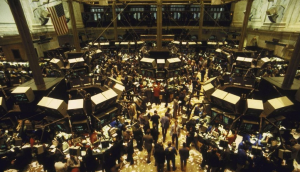 I graduated college in May of 1983 and soon realized my dream of making it to the Major Leagues wasn’t going to happen. During my junior and senior years, I worked at Irving Trust, located at 1 Wall Street directly across from the New York Stock Exchange (NYSE). When I graduated, my department manager offered me a full-time job at the bank. No, I wasn’t a bank teller, my position was in the government securities clearing department. The job paid pretty well and I was earning a good salary for a kid just out of college.
I graduated college in May of 1983 and soon realized my dream of making it to the Major Leagues wasn’t going to happen. During my junior and senior years, I worked at Irving Trust, located at 1 Wall Street directly across from the New York Stock Exchange (NYSE). When I graduated, my department manager offered me a full-time job at the bank. No, I wasn’t a bank teller, my position was in the government securities clearing department. The job paid pretty well and I was earning a good salary for a kid just out of college.
During one of my first lunch hours, I wandered down to the corner of Wall and Broad and was mystified by the number of people, mostly men, taking cigarette breaks while wearing these colorful jackets. I would routinely take my lunchtime walks past this iconic landmark and as the months passed, I became increasingly curious as to what went on in that building.
Remember, this was 1983. Cars and buses routinely made their way down Wall Street. Passersby were allowed to congregate right outside the historic NYSE building, navigating for space with the food vendor stands that lined the sidewalks.
The visitors’ gallery was open to the public. Here you were able to get a first-hand look at the “Main Room,” one of three trading rooms where pure capitalism was on display. CNBC had not made its debut yet, and Maria Bartiromo wasn’t appearing on our TV sets each morning at 10:00. Yes, back then the opening bell rang at 10:00.
In the mid-1970’s my uncle bought and therefore owned a “seat” on the NYSE. He was a member of the NYSE, a floor broker, able to conduct business on the trading floor. Mind you, at this time, the NYSE was not a public company; this would occur years later.
My first visit to the trading floor occurred in August of ’83. My uncle was anxious to have me see first-hand what transpired there each day. As I stepped on to the trading floor, I believe my initial thoughts were the same as many other first timers… “What are all these people doing and how do you keep track of anything with all this paper?”
The floor was full of life. Everywhere you turned, brokers were interacting with brokers. Trades were consummated not by computers, but by brokers trading with each other. Executed orders were reported back to customers via telephone. There was a pulse on the trading floor that you didn’t have in an office. I was hooked, and within two months, I resigned from the bank and took a job as a specialist clerk with a firm I would with stay with for the next twenty years.
Next Blog- The 1987 Stock Market Crash

